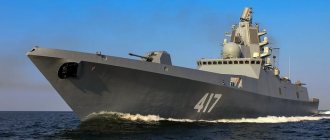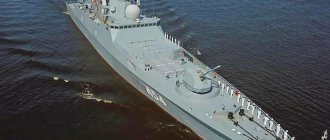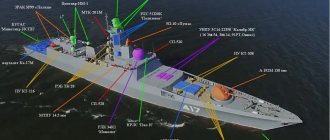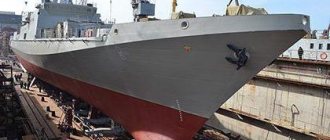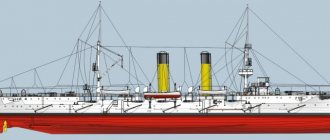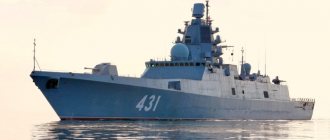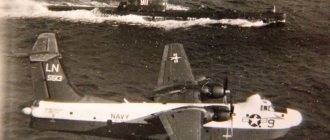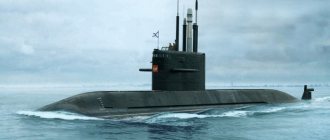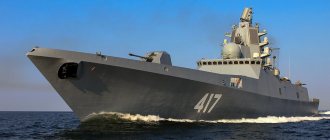French frigate FREMM against project 22350 “Admiral Gorshkov”. Who will win?
The French naval portal Naval Today reports that at the shipyard of the DCNS concern, which built the notorious Mistral universal landing ships for Russia, a flag-raising ceremony was held on the frigate Auvergne, which became part of the fleet of the Fifth Republic.
Frigates of the FREMM (Frégate multi-mission) type are a joint development of the French DCNS and the Italian Fincantieri. These ships are designed for anti-submarine and air defense, combating enemy surface ships and striking ground targets.
In total, the French plan to build from 11 to 17 ships of this class for their fleet, and Italy will order 10 more. Thus, FREMM frigates will become quite massive ships even by the standards of their class. And if so, it makes sense to compare them with the promising Russian frigates 22350 of the Admiral Gorshkov type.
Photo: arms-expo.ru
The Franco-Italian project is slightly larger than the Russian one. 400 tons more total displacement, 2 meters more length and 3 meters more width. True, our frigate does not sit so deep in the water: 4.5 meters versus five.
Each ship is equipped with two gas turbine engines, which in afterburner produce 25,000 (for the French) and 27,500 (for Russia) horsepower each. It is not difficult to guess that due to its greater power, the Russian frigate develops a higher maximum speed - as much as 29 knots versus 27 for FREMM. However, in economy mode, the French are ahead, at 15 cruising knots their ships can cover 6,000 miles, while Russian frigates have a cruising range of 4,000 miles at 14 knots cruising speed.
Photo: sdelanounas.ru
At the same time, the frigates’ armament fully corresponds to the variety of their tasks. Towed hydroacoustic stations provide search for submarines. To combat enemy surface ships, each frigate carries two launchers for 8 tactical missiles (SCALP for the French and Onyx/Caliber-NK for ours). Additionally, there is artillery, but in the Russian project it is the proven 130-mm AU A-192M gun, while the French have one or two 76-mm Oto Breda, or one 127-mm. But the Russian ship additionally provides cover for two Broadsword anti-aircraft missile systems.
In addition, both projects can be equipped with different types of missile weapons, and the weapons of the Franco-Italian project vary depending on the country of the operator.
Both projects have mine and torpedo armament, but the Russian frigate is better equipped and has a larger number of launchers. The air group is represented by Ka-27 or NH90 helicopters, but the Frenchman can carry one more helicopter if necessary.
Photo: daler.ru
In general, we have two quite worthy representatives of the frigate class, but there are some differences. The French ship's overall characteristics are more suitable for operations as part of a group, where different ships complement each other, compensating for their weaknesses. The Russian frigate of Project 22350 is more independent, capable of quickly completing a combat mission in isolation from the main group. True, you have to pay for this with a shorter cruising range. However, this price of independence is quite justified.
Project history
The history of FTI frigates began in 2013. It was you who this year included the medium frigate program in the so-called “White Book on Defense”. That is, in essence, a competition was announced for the design of this warship. However, the design work itself began later, in 2015. And already the following year, 2016, it was possible to see the interim results of these works at the Euronaval 2016 exhibition, when the shipbuilding company DKNS and the Directorate Generale des Armaments (DGA) of the French Ministry of Defense made an official presentation of the “conceptual design” of a promising “medium” frigate for the French Navy under the Frégate de Taille Intermédiaire (FTI) program.
Model of the “conceptual design” of a promising “medium” frigate of the French Navy under the Frégate de Taille Intermédiaire (FTI) program on display at the Euronaval 2016 exhibition. Le Bourget, 10/18/2016 (c) Luca Peruzzi / Jane's
The cost of the project was estimated at 3.8 billion euros, and its development was undertaken by a team of companies consisting of the above-mentioned DCNS, DGA and the Thales group. These frigates were planned to replace the La Fayette class frigates, which were built between 1987 and 1991.
Lafayette-class frigate
In total, the French Navy has 5 such frigates in service. Accordingly, it is planned to build 5 frigates of the FTI project:
- Amiral Ronarc'h,
- Amiral Louzeau,
- Amiral Castex,
- Amiral Nomy,
- Amiral Cabanier.
A contract has also already been signed for the supply of these frigates to Greece. This Balkan country will receive 4 such frigates. There is a preliminary agreement on the purchase of ships by Egypt. But the quantity has not yet been specified.
French merchant ship
These ships were mainly called naves, but some used terms such as hulki and kilsa, and in rare cases buza. They had key features - a rounded nose and stems raised to a sufficient height. The ships were equipped with a single mast. Thanks to the introduction of a mounted rudder, it became possible to use side winds when moving. In addition, the draft was increased, which made it possible to accommodate a larger volume of cargo. They began to equip the bowsprit, the shrouds were supplied to the shrouds, and the anchor looked like an Admiralty anchor.
The ship could transport 200 tons of cargo at once. Tack clamps were fenced with wood. Their main purpose was to guide thick ropes, which differed from the sheet, where there were no hoists. Stays and other rigging elements were moved to the rear of the ship.
The design of the nave provided for the presence of extensions in the front and rear parts, presumably for the landing of soldiers, as they were used by the crusaders. To improve their appearance, they were equipped with combat shields with a coat of arms.
French pinasse (pinnace) – 17th century
The 17th century in Europe was marked by the appearance of the pinnacle, which in its main characteristics was similar to the flute, but the differences were the frames and stern. The first began to have an increased bend directed inward, and the second began to be performed in a flatter version. In the bow of the ship there was a transverse bulkhead that extended upward, close to the forecastle. This design feature remained until about 1700. The length of the ship was close to 44 meters. 3 masts were installed, a reinforced bowsprit, on which there was a blind and a bomb blind. Rectangular type sails were attached to the foremast and mainmast. The cruisel was held on the top of the mizzen mast, with the mizzen underneath it. The ship's displacement could vary, ranging from 150 to 800 tons. They were used primarily by merchants to transport goods.
Content
- 1 Design 1.1 Propulsion system
- 2.1 Equipment and weapons common to all variants
- 3.1 Construction
French galley "La Ferme" - 1691
Compared to the La Real galleys, which were large in size, this type of French ship was quite small. La Ferme was 46.7 meters long and 5.8 meters wide. The draft was 1.6 meters. It was equipped with 3 masts, each of which had a lateen, beveled sail. All together, sailing sheets could occupy 850-1150 sq.m. The width of the ship was up to 6 meters. This length-width ratio had an excellent effect on maneuverability, regardless of the method of movement - sailing or rowing. The latter were located on 18 banks equipped on each side. The total number of rowers reached 180 people. The vessel shown in the image dates back to 1691. In terms of external design, La Ferme is much inferior to La Real.
Construction and career[edit]
Auvergne
was developed as part of a joint Italian-French program known as FREMM, which was implemented to develop a new class of frigates for use by various European navies.
Auvergne
was launched on September 2, 2015
Views of Auvergne
- Auvergne
in Fremantle November 18, 2022. - USS Nimitz and frigates Jean Bart and Auvergne,
September 19, 2022.
- A French naval aviation NHIndustries NH90 helicopter lands in Auvergne
.
French galley "La Reale" - 17th century
The name itself indicates that the ship belongs to the Royal Navy. Beginning in 1526, similar ships began to act as flagships for the French fleet. If a royal person came aboard, then a standard was raised on the galley, adjacent to the Admiralty flag. It is believed that only in the 17th century the ship received its finished appearance and design. The decoration of the ship, which is drawn on the postcard, was done by the famous sculptor from France - Puget. The Paris Museum houses some of the exterior design elements, as well as a scale model. This impressive vessel reached 52 meters in length and 6.4 in width. A total of 62 cans were present, and a galley was in place of another 2. For movement, large 15-meter oars were used, controlled by 7 rowers at once, the total number of which was 427 people. At the front of the ship there were 5 cannons - 18, 24 and 36 pounds. There were also guns on the sides - 6 on each side. While moving through “free water,” the sails were used, and when conducting combat operations, the rowers took over.
French warship La Coronet - 1636
This postcard shows a sailing ship from 1636. It was rightfully considered the best among all those created in France, from all points of view. Oak was used to produce the body, but there was an important feature - for certain parts, a separate trunk was selected, the most suitable in size. Thanks to this approach, it was possible to significantly increase the strength characteristics, since the fibers remained intact. It took about 2,000 oak trunks to create the hull of 1 ship. The length of the ship reaches 70 meters, and the water level is 50.7, with a width of 9.3. The board hung 10.5 meters above the surface. The displacement reached 2100 tons. There were 3 decks on which 72 guns, large and small caliber, were installed. The mainmast is 57.6 meters high. The sails cover an area of more than 1000 sq.m. 638 people can be accommodated on board at the same time.
French Pink “Filez” – 15th century
This ship, or rather a type of ship, had a small stern. The first data about it were found in the 15th century, and the latest date back to the 18th century. Pink, created in the north of Europe, was equipped with 2 masts, and closer to the Mediterranean Sea they used three-mast options. In both cases, beveled sails were used, a jib was attached to the bushpit, and a cruisel was located above the mizzen. All this made it possible to achieve high maneuverability and good speed. There were up to 30 guns, but the ship was not used directly in combat. It was often used as a merchant vessel, fishing vessel, or for delivering food to larger representatives.
Pink, which is in the picture, was created in Marseille in 1778.

